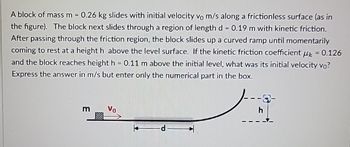Question

Transcribed Image Text:A block of mass m = 0.26 kg slides with initial velocity vo m/s along a frictionless surface (as in
the figure). The block next slides through a region of length d= 0.19 m with kinetic friction.
After passing through the friction region, the block slides up a curved ramp until momentarily
coming to rest at a height h above the level surface. If the kinetic friction coefficient μk = 0.126
and the block reaches height h = 0.11 m above the initial level, what was its initial velocity vo?
Express the answer in m/s but enter only the numerical part in the box.
m
h
Expert Solution
This question has been solved!
Explore an expertly crafted, step-by-step solution for a thorough understanding of key concepts.
This is a popular solution
Trending nowThis is a popular solution!
Step by stepSolved in 3 steps with 2 images

Knowledge Booster
Similar questions
- A toboggan starts from rest on parliament hill which is 5.0 m above road level. The toboggan slides down the frictionless hill, then crosses an 7.0 m patch of level asphalt on which the coefficient of friction is 0.50. What is the speed of the toboggan after it crosses the road?arrow_forwardA small block moves at point A with a speed of 7 m/s. Its path is without friction until it reaches the section of length L = 9 m where the coefficient of friction is 0.7. The indicated heights are h1 = 6m,h2 = 2 m. What is the speed of the block at point D? (Take g = 10 m/s, write the answer with 2 decimal places only). Answer:arrow_forwardIn the figure, a 4.2 kg block slides along a track from one level to a higher level after passing through an intermediate valley. The track is frictionless until the block reaches the higher level. There a frictional force stops the block in a distance d. The block's initial speed is vo = 6.5 m/s, the height difference is h = 1.1 m, and k = 0.593. Find d. Number Units μ=0- -μkarrow_forward
- A pendulum consists of a small object hanging from the ceiling at the end of a string of negligible mass. The string has a length of 0.80m. With the string hanging vertically, the object is given an initial velocity of 1.9 m/s parallel to the ground and swings upward in a circular arc. Eventually, the object comes to a momentary halt at a point where the string makes an angle with with it's initial vertical orientation and then swings back downward. Find the angle.arrow_forwardA 3 kg block travels along a horizontal surface with a coefficient of kinetic friction of 0.28 at a speed of 7 m/s. After sliding a distance of 1.4 m the block makes a smooth transition to a ramp with a coefficient of kinetic friction of 0.28. How far up the ramp does the block travelled before coming to a momentary stop.arrow_forwardA chain with length b and mass M is hang on ceiling under constant gravity g. Find the tension at point A when the distance between the ceiling and B is x for each casese. (1) The chain free falls. (2) Energy is conserved. A B CM T A B t=0 time t> 0 CMarrow_forward
- A block of mass 11.0 kg slides from rest down a frictionless 36.0° incline and is stopped by a strong spring with k = 2.30 ✕ 104 N/m. The block slides 3.00 m from the point of release to the point where it comes to rest against the spring. When the block comes to rest, how far has the spring been compressed?arrow_forwardA block weighing 2.50 kg begins its motion from a stationary position at point A, located at the highest point of a frictionless ramp. The ramp is inclined at an angle of 40° relative to the horizontal and has a length of 1.50 m. As the block slides down the ramp, it reaches a region between point B and point C, which is a rough horizontal surface with a kinetic friction coefficient of 0.30. After covering a distance of 1.00 m on the horizontal surface, the block encounters a lightweight spring with a spring constant of 900 N/m. Find the speed of the block at point B?arrow_forwardA 5.2 × 105 kg train is brought to a halt from a speed of 0.65 m/s in 0.45 m by a large spring bumper at the edge of its track. What is the force constant k of the spring in N/m?arrow_forward
- Can you help me with this problem?A block with a mass m is initially compressing a spring by x1 on a horizontal floor with friction. The spring has a spring constant k. The block is realeased from rest and travels a total distance of D including x1 and has a speed of v. what is the coefficent of kinetic friction between the floor and block?arrow_forwardProblem 10: The speed of a block traveling on a horizontal frictional surface changes from v; =16 m/s to v= 11 m/s in a distance of d = 8.5 m.arrow_forwardIn the figure here, a small block is sent through point A with a speed of 6.9 m/s. Its path is without friction until it reaches the section of length L = 13 m, where the coefficient of kinetic friction is 0.76. The indicated heights are h1= 6.0 m and h2 = 2.4 m. What are the speeds of the block at (a) point B and (b) point C? (c) Does the block reach point D? (d) If so, what is its speed there; if not, how far through the section of friction does it travel? %3D D (a) Number Unit (b) Number Unit (c) (d) Number Unit B.arrow_forward
arrow_back_ios
SEE MORE QUESTIONS
arrow_forward_ios